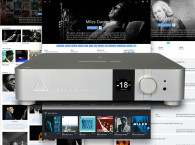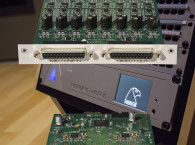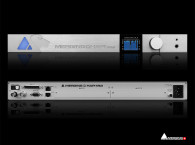

But of course it was also possible to listen to the complete Network Attached DAC solution, directly connected to a pair of exceptional Philharmonia’ 2-way, self-powered speakers designed by Michel Deluc and Jean Nouvel, from the French company Amadeus – also making its debut at the Munich Show. The music was being played by the also new Emotion music server - which will be bundled with every NADAC and runs on Mac OS X and Windows platforms.
The listening experience, even in a lower volume and in the middle of a trade show environment, was extremely detailed and pleasant, leaving everyone who had the opportunity to experience it wishing for more. For a different experience, it was also possible to listen to the NADAC own headphone preamps, with OPPO’s PM1 or Grado GS1000e headphones. Unfortunately, with both models being open-back, the experience, although impressive, didn’t allow any specific impressions due to the noise levels in the area.
Of course for any of the unaware High End visitors, accustomed to USB DACs, the Ethernet-based solution spawned a lot of curiosity and Merging’s staff on the both had to continuously explain why the company decided – a long time ago – not to develop USB-based products and go for an Ethernet solution. Robustness, better synchronization and the possibility of establishing a real networking configuration based on the same technology, for multisource and multizone installations are just the main reasons which make sense for the consumer market – but it goes way beyond that. And yes, the computer itself “talks” to NADAC through Ethernet/AoIP, because Merging developed Ravenna drivers for both Mac (CoreAudio DoP) and Windows (ASIO). In fact, an Ethernet connection from a Mac using the Ravenna drivers doesn’t suffers from any of the limitations which are know to USB interfaces when dealing with DSD 256.

As Claude Cellier explained to the many visitors, NADAC can be considered the missing link between the world of DSD or high resolution audio files – which are increasingly available online – and the consumer high-end market wishing to get experiences as close to the quality of the original recordings as possible. And no other company other than Merging Technologies can claim what they are offering is as close to what the producers, audio engineers and musicians have heard when those recordings where originally created, because NADAC uses the same components and professional D/A converters currently used by Merging’s Hapi and Horus professional audio interfaces – also based on Ravenna/AES67 AoIP technology.
Merging Technologies was a pioneer in the early days of DSD and Super Audio CD (SACD) and is by far one the largest supplier of complete professional high resolution recording systems for record labels and most of the more demanding productions, including the most prestigious classical music labels. The company develops and manufactures high-resolution digital audio recording and editing systems including products that process PCM formats up to 24-bit/384kHz, including DXD, and DSD up to DSD256. The bulk of the DSD downloads now available on the numerous specialist websites were recorded on Merging Technologies’ systems.
And certainly because of the connection between Merging and the world of multichannel SACD and DSD/DXD production, NADAC will be also delivered in stereo and 8-channels versions. Both variants have ¼” and mini-jack headphone outputs and the monitoring-grade headphone outputs can be configured to carry a different signal to the main output, which can be analog balanced and unbalanced line outputs.

by a strong consortium of companies.
Cordial even launched a special
Ravenna-themed Ethernet cable!
NADAC covers PCM formats up to 24-bit/384kHz and DSD up to DSD256. It has AES/EBU and SPDIF digital inputs for use with CD players, CD transports or other devices up to 192kHz. The provided Ethernet interface allows computer based digital audio systems to carry through any resolution up to 384kHz, DXD and DSD256, using the Ravenna protocol that Merging Technologies helped to develop for high sampling rate applications and allows very robust and accurate transfer of the digital audio data from the computer to NADAC.
The data is stored in a large buffer memory in the NADAC and then clocked out by the unit’s precision internal clock. This and the Ravenna protocol’s ultra-stable Precision Time Protocol (IEEE 1588) eliminates the cable and jitter related problems associated with conventional digital audio interfaces.
The NADAC’s line outputs are driven by an ESS9008S SABRE Reference Audio D/A IC. This IC has 8 separate D/A converters and in the stereo version of the NADAC, each channel uses 4 D/A converters with the outputs summed in order to provide improved linearity, greater dynamic range and a lower noise floor. The 8-channel version of the NADAC may also be switched to work as a stereo unit, with the converters configured in the same way.
Another important detail in Merging Technologies’ presentation is the number or recording partners involved. Merging is forming a dynamic partnership with a growing number of these content providers, to jointly promote the benefits of the listening to the music as the artists intended. Special deals for NADAC purchasers will be announced as they are made available.
For more details about NADAC, Ravenna and Merging Technologies go here.
The NADAC will be on show in the Boardroom/Thinktank and in Room 441 at T.H.E Show, Newport from 29-31 May. Merging’s NADAC product manager, Dominique Brulhart will also participate in “DSD and Analog: The Great Convergence” on Saturday 30th May at 4.00pm. The venue is Salon A in the Grand Ballroom, The Hotel Irvine.
www.merging.com
nadac.merging.com







